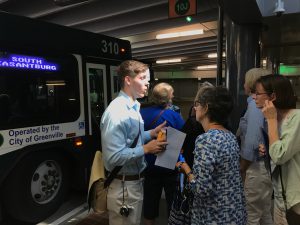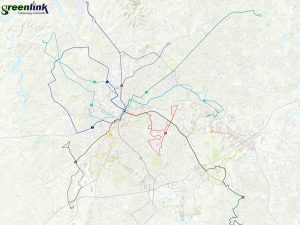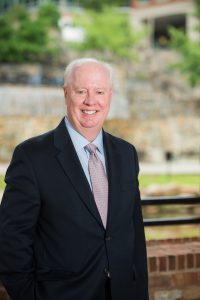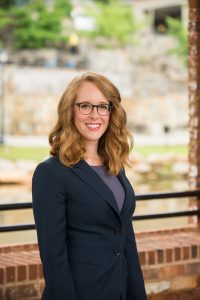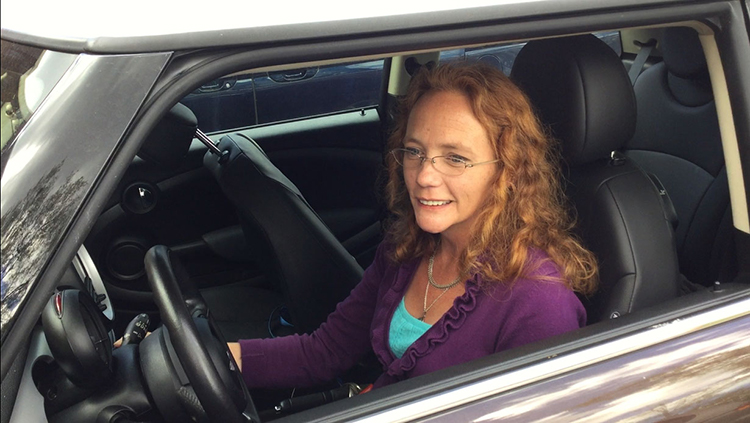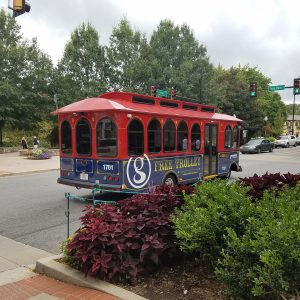 The downtown trolley is Greenlink’s most popular service, providing nearly 120,000 rides to residents and visitors in 2016. Because the service was so popular, Greenville City Council decided to set aside Hospitality Tax funds to expand the trolley system from one Main Street route to four separate routes. Since the routes launched August 3, 2017, we have heard many common questions arise about the new trolley system. In an effort to get the correct information we sat down with Nicole McAden, Greenlink’s marketing and public affairs specialist, to get the run down.
The downtown trolley is Greenlink’s most popular service, providing nearly 120,000 rides to residents and visitors in 2016. Because the service was so popular, Greenville City Council decided to set aside Hospitality Tax funds to expand the trolley system from one Main Street route to four separate routes. Since the routes launched August 3, 2017, we have heard many common questions arise about the new trolley system. In an effort to get the correct information we sat down with Nicole McAden, Greenlink’s marketing and public affairs specialist, to get the run down.
Q: First, what are the basics of the expanded trolley system?
Where do the trolleys operate? The four trolley routes – Heart of Main, Top of Main, Arts West, and Augusta – can be viewed here.
When do the trolleys operate? – Thursday and Friday 6 p.m. to 11 p.m., Saturday: 10 a.m. to 11 p.m. and Sunday: 1 p.m. to 8 p.m. It’s important to note that the last trolley run of each night will depart from the trolley hub on Falls Park Drive 30 minutes prior to end of service. This should allow for the trolley to make one last complete loop before service ends for the night. This does not mean that the trolley will service each stop until 11 p.m.
Track the real-time location of the trolleys thanks to Code for Greenville, a volunteer team of programmers, with the Trolley Tracker app. Download it free at www.YeahThatTrolley.com
Food and beverages – You may bring drinks that have a secure lid. No open solo cups, cans, bottles, or fast food type cups (paper cups with plastic lids and straws). Food may be transported, but must remain in containers and cannot be consumed on the trolley.
Q: How is the trolley system different from the regular fixed route bus system?
A: The trolleys are funded with City of Greenville Hospitality Tax funds (along with a Federal Transit Administration match), so they must serve City of Greenville hospitality-related venues. The idea behind expanding the trolley system is to provide a way for people to access destinations that are outside of the downtown core in an effort to share this success with other restaurants, retail establishments, parks, and tourism facilities in the city. Its hours of operation are limited to Thursday and Friday from 6 p.m. – 11 p.m., Saturday from 10 a.m. – 11 p.m., and Sunday from 1 p.m. – 8 p.m.
The existing fixed route bus system provides transportation to a variety of locations, including jobs, schools, shopping, residential and retails areas, and more, and is funded by federal, state, and local sources and passenger fares. It runs in various geographic locations throughout the county. Its hours are Monday – Friday, 5:30 a.m. – 7:30 p.m. and Saturday 8 a.m. – 6 p.m.
Q: What process was used to create the new routes?
A: The Greenville Transit Authority board of directors passed a set of criteria that trolley routes must meet, many of which are required since the trolleys are partially funded using City of Greenville hospitality taxes. The characteristics include:
– New routes must provide service to the Central Business District (CBD)
– New routes provide service between the CBD and other hospitality venues
– New routes provide connections to leisure/recreation facilities
– New routes provide connections to tourism facilities
– New routes provide connections to residential areas
Additionally, Greenlink staff established the following operational goals:
– Route length is under 5 miles
– Route headways – the time it takes for the trolley to run the full route – are under 30 minutes
– Routes are connected and integrated with a common hub to allow for transfers from one trolley to another
Once the criteria were set and proposed routes were drawn, Greenlink staff held three public hearings to gather input and feedback, much of which were incorporated into the new routes that are running today.
Q: Where can you get on and off the trolley?
A: To ensure safety, passengers are permitted to board and exit the trolleys only at designated trolley stops. A map of the trolley routes and stop locations can be found on the Greenlink website at: www.RideGreenlink.com/Trolley
Q: Can I request new stops to be added?
A: Not surprisingly, the new trolleys are popular and residents are already submitting requests and ideas for stops, and Greenlink staff are continually evaluating the stop locations in order to make changes that would better serve passengers.
There are some requirements that every stop must have, which include:
– Space to pour an 8 ft. by 5 ft. concrete pad. This landing pad must be flat and tied into other infrastructure (such as sidewalks) to adhere to the Americans with Disabilities Act and create access for all ranges of mobility. The trolleys are equipped with a wheel-chair ramp or lift, and this pad is an essential component to ensuring the ramp/lift works correctly.
– Approval from the entity that owns and maintains the roadway. Many streets throughout Greenville are actually owned and maintained by the South Carolina Department of Transportation. Before Greenlink can install any new stops on an SCDOT roadway, Greenlink must obtain an approved encroachment permit from SCDOT. The permitting application ensures that the stop won’t create any new safety hazards.
– Adjacent property owner buy-in. The point of the trolleys are to provide transportation for tourists traveling through town. Many businesses are excited about stops being installed near their location, as it could lead to increases in customer traffic. However, trolley stop locations throughout residential neighborhoods are trickier, and Greenlink is interested in pursuing stop locations that are agreed upon by the adjacent property owners. While the stops are installed in the public right-of way, and therefore don’t require property owner approval, it’s important that Greenlink receive support from the neighbors.
The Arts West Route and the Augusta Route are both funded through October 2017. Between the months of November 2017 to April 2018, Greenlink staff will evaluate service performance and make tweaks to service.
Q: Can I rent the trolley for private events?
A: No. We know residents love the trolleys, but the Federal Transit Administration prohibits any charter services from agencies using vehicles intended for public transportation.
Q: Will we see trolleys anywhere in the County or other municipalities?
A: The City of Greenville was interested in bringing trolleys to City residents and visitors to transport them to hospitality destinations using hospitality tax dollars. If other local governments or private funders or companies are interested in exploring using trolleys or other forms of transit to move residents and visitors, Greenlink staff are willing to explore the opportunities.

